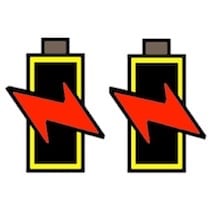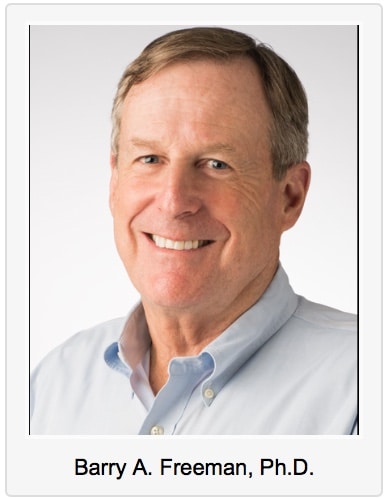A previous post on this subject suggested that a new era is being entered where consumers no longer have to deal with the hassles of replacement disposable batteries. Instead, the trend will be to hearing aid rechargeable batteries.
This is a second part of that article and is directed at these trends, concentrating on the differences to be expected between the various types of battery chemistries, concentrating on rechargeable batteries for hearing aids.
Effective Capacity of Size 312 and Size 13 Rechargeable Batteries
This information becomes relevant when evaluating the rechargeable options coming to market through manufacturers this year. For example, as shown in Figures 1 and 2, Silver-zinc (AgZn) rechargeable batteries have more capacity than the other chemistries. While silver-zinc loses its energy advantages in larger sizes like cell phones and automobiles, no other chemistry can offer the capacity of silver-zinc at the sizes of hearing aid batteries. At this time, Lithium-ion cannot be scaled down in size smaller than slightly larger than a size 13 hearing aid battery.
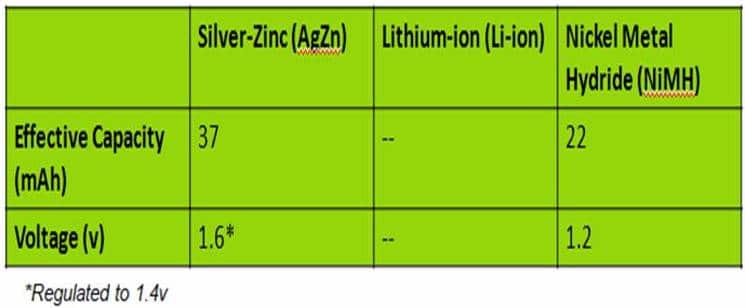
Figure 1. Effective capacity of size 312 rechargeable hearing aid batteries currently available. AgZn has significantly more capacity than NiMH. Lithium-ion is not available in this size.
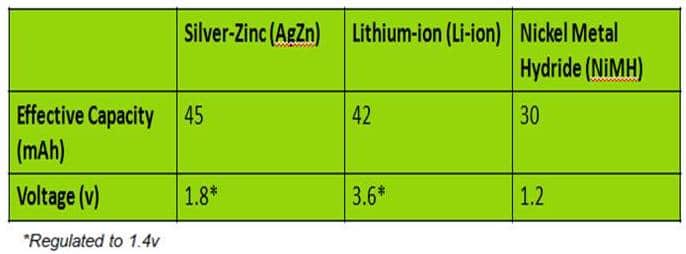
Figure 2. Effective capacity of size 13 rechargeable hearing aid batteries currently available. AgZn has more capacity than NiMH and Li-ion at these sizes.
It also is well known that Li-ion batteries lose their capacity over time as shown in Figure 3. While cell phones, for example, may last a full day when they are new, it is typical for them to lose capacity and, therefore, battery life over time. This is a common characteristic of Li-ion batteries which tend to lose capacity with each charge. Although there is no history of capacity-loss with Li-ion batteries that power hearing aids, it is anticipated that they could lose as much as 20%-30% capacity every six months.
Lithium-ion capacity loss could impact full-day hearing aid wear time depending on the features and streaming behaviors of users. As noted in the description of Figure 4, it is probable that Li-ion hearing aid batteries will begin to lose capacity and battery life over time. Silver-zinc always recharges to full capacity. It does not have the capacity loss challenges of Li-ion. However, after about a year, the length of the charge time of silver-zinc will increase until it no longer charges to full capacity.

Figure 4. Size 13 rechargeable hearing aid batteries after 300 charges. Silver-zinc continues to recharge to full capacity. A characteristic of Lithium-ion is to lose 20-30% capacity after 200 charges. This typically continues throughout the life of the Li-ion battery. Nickel Metal Hydride must be replaced after 300 charges.
Battery Life Based on Hearing Aid Usage
The impact of battery capacity loss on users will depend on their hearing aid usage and wear behavior such as features and streaming. Figure 5 presents a hypothetical use case of the performance of these two different battery chemistries with NFMI (Near-Field Magnetic Induction) streaming hearing aids when they are new, and after 200 charges. Since silver-zinc retains capacity throughout its recommended one-year life, the hearing aid will continue to perform after a year in the same way it did when it was new. Lithium-ion, however, typically loses capacity over time and, therefore, it might reduce the wear time of the hearing aid depending on the amount of streaming and features that are activated in the hearing aid.
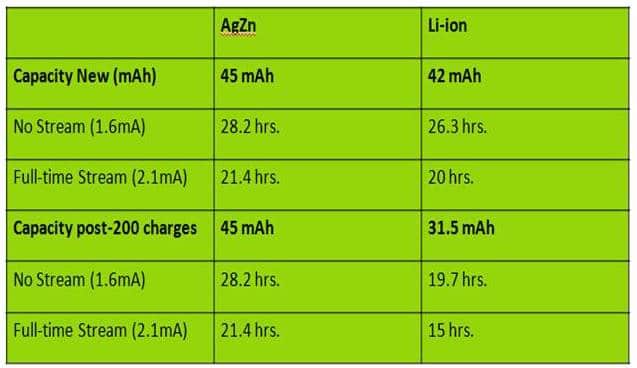
Figure 5. Hypothetical comparison of the performance of size 13 silver-zinc and Li-ion rechargeable hearing aid batteries with NFMI hearing aids when new, and after 200 charges.
Proper Consumer Counseling
Hearing care providers must evaluate the wear habits of their customers and then select appropriate products to meet their hearing needs. Building consumer trust depends on providing accurate information about the products. Not all rechargeable solutions are the same so there is a need to know the products and how they perform.
Summary
This should be an exciting time for both providers and hearing aid users as a time is entered when hearing aids no longer will need to use disposable batteries. It’s a time when counseling and instructions will not require the consumer to learn about replacing the battery and they will not be frustrated by this task. Most definitely, there will be an adoption and learning curve for everyone as the performance of these different battery chemistries is evaluated, especially as hearing instruments evolve and offer more features and users increase their streaming habits. The moment should be enjoyed, and perhaps in a few years all can remember the old days when hearing aid users had to change their batteries every 3-5 days!
References
- Buchmann, I. Basics about batteries. I. batteryuniversity.com (2016)
For additional readings about hearing aid batteries, check these posted on this site: May 8, 2012; February 17, 2015; January 5, 2016; February 9, 2016; February 16, 2016; February 23, 2016; March 1, 2016; and March 15, 2016.
*Barry A. Freeman, Ph.D. is Vice President, Business Development of ZPower Battery, LLC. He is a past-president of the American Academy of Audiology and served on the Academy’s Board of Directors for six years. He received the Distinguished Achievement Award from the American Academy of Audiology in 2006.



